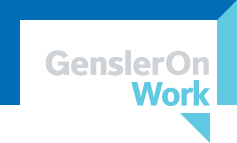Collaboration is here to stay—Let’s deal with it
 Judy Pesek
Judy Pesek 
Group work, by nature, is a messy, chaotic process for which there is no reliable template. The nature of group work changes from project to project, group to group, and at times its unpredictability can exasperate participants.
But here’s the rub: Almost all the best ideas are the product of collaboration. The myth of the lone genius conjuring up innovative solutions in a dingy study works great at the movies, but we all know from personal experience that this not how companies find solutions in the real world.
Today’s workforce is dedicating less of the workday to “head’s down” time and spending more time working in group settings. Don’t believe me? A study by MIT indicates that 70 percent of what people know about their job comes from interaction with colleagues. Learning the necessary tricks and techniques for a particular position is better accomplished via conversations in the break room than by reading alone at a desk for several hours.
Like all workforce evolutions, this shift towards collaboration is changing the paradigm for smart office design. Cubicle walls are going the way of the dinosaur—in 10 years you won’t be able to find a fully cubicled workplace outside of an old Dilbert comic strip. The amount of office space dedicated to housing collaborative activities, such as video-conferencing, is increasing. Managers are realizing that face time promotes collaboration, which in turn promotes the generation of new ideas, and they are demanding offices that give coworkers open sight lines to each other.
All of this has ramifications for individual workspace, which, as many of you may have noticed, is shrinking. Some people are pushing back on this trend. They don’t like distractions and detest when someone interrupts their train of thought. Others understand that the office is now a place where knowledge sharing is the primary activity.
Some of this push back is generational Baby Boomers and older Gen Xers are not accustomed to fully collaborative working environment, while Gen Yers and Millenials grew up with their attention divided between multiple activities and are fully comfortable working in environments where simply swinging a chair around puts them face to face with a co-worker.
What members of the older generation need to realize is that as they begin to hand over the reins to their younger colleagues, increased collaboration will help facilitate the transfer of critical knowledge that younger employees need as they assume more senior responsibilities. This is not a time for seasoned workers to fight the collaboration trend. Rather, they are in a unique position to use collaboration to their advantage while simultaneously providing feedback about how office design can balance the need for collaboration with the needs of individual privacy—even the most collaborative amongst us relishes a bit of time in the workday to focus on a single, private activity.
So finding this type of balance while promoting the values of collaboration to all workers is what office designers need to turn their attention to. Doing so will promote more knowledge sharing and help companies increase their productivity.
 |
Judy Pesek is the co-regional managing principal of Gensler’s southcentral region and a founding member of the firm’s Workplace Taskforce. An interiors dynamo, Judy lends her considerable workplace expertise as an adjunct professor at UT Austin and as a regular contributor to D-CEO magazine in Dallas. Contact her at judy_pesek@gensler.com. |


Reader Comments